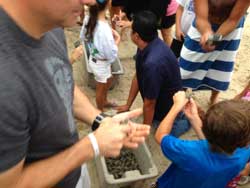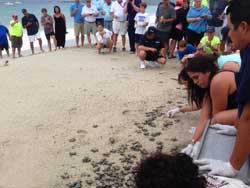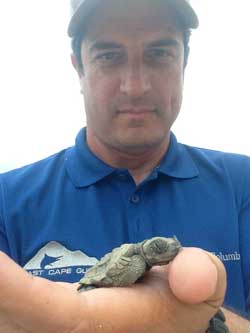

Turtle Release Program
Release your own turtle into the Sea of Cortez

Run by brothers Noe and Omar Araiza, the turtle hatchery and release program on the East Cape has been an amazing success story of two individuals that wanted to make a difference. In 2012, with only local funding, the brothers established a turtle monitoring, hatchery and release program with a protected nursery on the beach. Every morning they patrol a 12 mile stretch of beach looking for any turtle nests, transferring eggs more than 30,000 to the nursery for release during a nesting season. The incubation process takes approximately 45 days. When ready, guests of Van Wormer Resorts are invited to release juvenile turtles at a scheduled time and location in the July-November nesting season. A donation of $5 per person is greatly appreciated to sustain the program.


More About the Turtles of Baja
 Sea turtles migrate the world's oceans and have come to the beaches of Southern Baja to lay their eggs for millions of years. Two of the world's eight sea turtle species nest in our backyard, The East Cape. The smallest, the Olive Ridley, also known as the golfina, nests June - December. The golfina feeds on shrimp, jellyfish, snails and algae, and can grow to 26 inches long, weighing up to 90 pounds. The largest marine turtle, the Laud, or leatherback, nests on our beaches from November through February. Leatherbacks grow up to 70 inches long, weighing up to 1,300 pounds. Its favorite food is jellyfish, and it will dive up to one kilometer in search of food. Golfinas, and especially leatherbacks, are endangered species, suffering from the effects of long lines, fishing nets, development, and illegal poaching.
Sea turtles migrate the world's oceans and have come to the beaches of Southern Baja to lay their eggs for millions of years. Two of the world's eight sea turtle species nest in our backyard, The East Cape. The smallest, the Olive Ridley, also known as the golfina, nests June - December. The golfina feeds on shrimp, jellyfish, snails and algae, and can grow to 26 inches long, weighing up to 90 pounds. The largest marine turtle, the Laud, or leatherback, nests on our beaches from November through February. Leatherbacks grow up to 70 inches long, weighing up to 1,300 pounds. Its favorite food is jellyfish, and it will dive up to one kilometer in search of food. Golfinas, and especially leatherbacks, are endangered species, suffering from the effects of long lines, fishing nets, development, and illegal poaching.
Most mature sea turtle females return to the beach of their birth, called a natal beach, to dig their nests and lay their eggs at night. Only about one in 1,000 of their offspring will survive the treacherous journey from the nest to maturity. After incubation, they hatch, and take several days to claw their way out of the nest, instinctively making their way to the sea, following the moon and the horizon. Many fall prey to birds as they struggle to reach the shore, others are led off track by deep grooves left from vehicular traffic and disorienting artificial lighting from beachfront hotels and residential areas. Once in the ocean, they face new predators or ffall victim to long lines, gillnets, poaching and pollution.
Sea turtle nursery programs greatly improve hatchling survival rates through the first critical stage of their lives. The tiny hatchlings are returned to their nesting area, and released close to the sea at sunrise or sunset. Some programs groom the sand smooth to make the journey to the sea easier.
MARLIN * TUNA * DORADO * WAHOO * ROOSTERFISH

